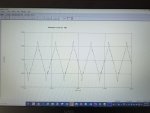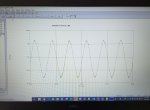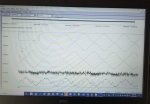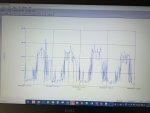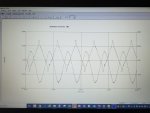Why do you say you don't think it could be power factor?
In your first picture the neutral current exceeded each of the L1 and L2 line currents. If these line currents were equal then this would require them to be at phase angles less than 120° apart from each other. Or in other words a more than 60° departure from the normal 180° between the L1 and L2 currents if there were purely resistive loads.
One scenario to make this happen would be resistive loads on L1 (i.e., power factor PF = 1.0), and a 120V motor but
no other loads on L2 that might increase the PF of the total L2 current. Then the motor PF would have to be less than cos(60°) = 0.5 which implies the motor is running at less than 1/2 of its full load amperage. At half load a 5HP motor would typically draw a little over 20A at 120V.
Adding any L-L loads of course increases the line currents but not the neutral current, and so the difference in PF's between the L1-N and L2-N loads would have to be even more to keep the neutral current higher than the line currents.
The bottom line is that it's unlikely that PF is causing your excess measured neutral current, unless you have a situation like I described above.
Also, if current was finding an alternate path back to the transformer wouldn't that mean I would see less than the difference between the two phases on the neutral? The excess neutral current is always 3amps or more. In the last picture I uploaded it is 8.2amps excess. That seems pretty substantial.
There could be an alternate path that you are not including in your measurements but it doesn't have to be all the way back to the transformer. In the example I posted with two neutral bars, the alternate path started in the watt-meter at the point the grounded conductor (neutral) was bonded to the meter housing. The alternate path was the metallic conduit between the meter and panel.
Also the current isn't necessarily reduced because there is an alternate path. It would only be reduced if the currents on the main and alternate paths are flowing in the same direction and then split. In the example I gave with two neutral bars the AC current flows back and forth through a section of the main path (neutral conductor) and the alternate path (conduit), from one neutral bar to the other. This is because the current on one neutral bar is 180° out of phase with the other because the line voltage on their loads is 180° from each other.
In the ideal case the branch circuit neutrals are tied to one point and balanced L1-N and L2-N currents flow from one leg to another, with no net current on the neutral service conductor. In the scenario I gave with two neutral bars the point where the L1-N and L2-N currents are tied has been brought upstream to the neutral / meter housing bond connection. And so the neutral current upstream of this bond should be small with equal L1-N and L2-N loading.


